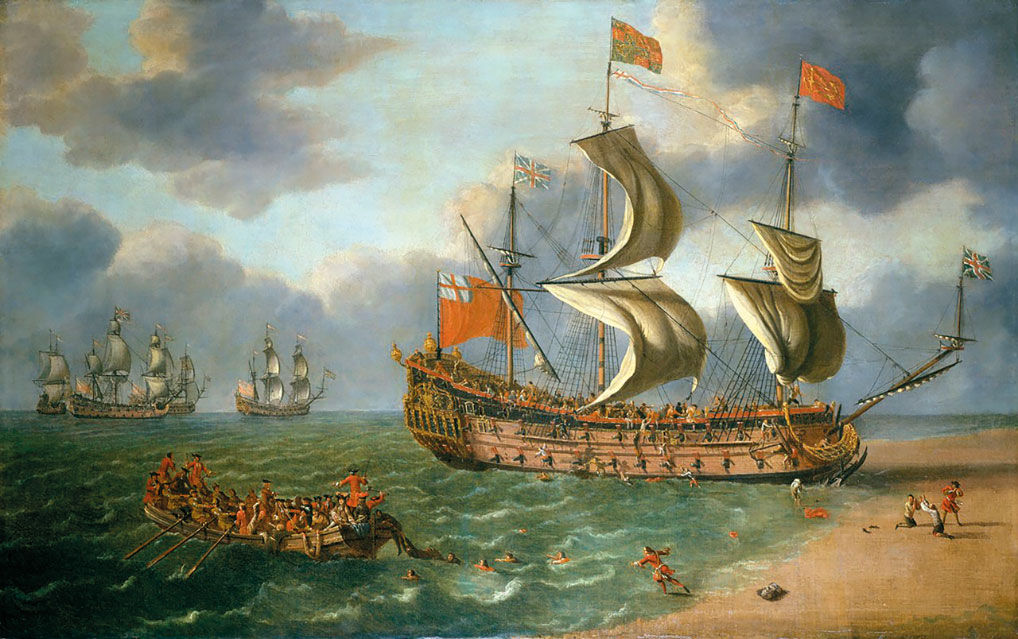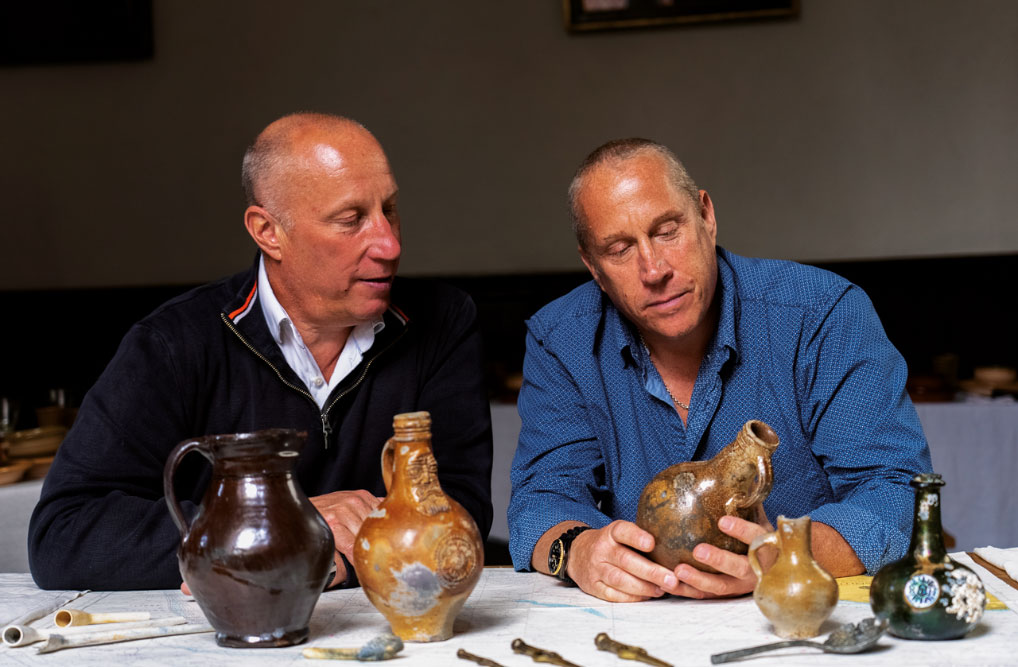
Above: The Wreck of the Gloucester, 1682, by Johan Danckerts
The secrets of Norfolk’s Mary Rose
The wreck of the 17th-century Royal Navy ship the Gloucester is the most important discovery off Britain’s coast in a generation, and its tragic fate is the subjectof a fascinating exhibition, says Rebecca Wallersteiner
On 6 May 1682 a Royal Navy warship carrying James Stuart, the future King of England and Scotland, hit a sandbank and ran aground in heavy seas off the coast of Great Yarmouth, while en route to Edinburgh. Within an hour the vessel sank, with the loss of many lives, and for 325 years the wreck and its contents lay buried on the seabed.
Now, a major exhibition at Norwich Castle Museum (until 10 September), co-curated by Norfolk Museums Service and the University of East Anglia, explores the final journey of the ship and its dramatic discovery, in 2007, by brothers Julian and Lincoln Barnwell, their late father, and their friend James Little.
On display for the first time are some of the fascinating objects recovered from the wreck, including wine bottles (mostly unopened), women’s clothes, a pair of spectacles kept in a decorative case, a urine bottle, clay pipes and combs. Most striking is the ship’s bell – which confirmed the vessel’s identity and is on show alongside beautiful paintings, manuscripts and navigational instruments loaned by museums around Britain and Europe.
‘We are delighted to share the extraordinary history of the wreck of the Gloucester and the artefacts that movingly speak of the tragic events of 1682,’ say the curators of the exhibition, Ruth Battersby Tooke and Dr Francesca Vanke of Norfolk Museums Service, and Professor Claire Jowitt and Dr Benjamin Redding from the University of East Anglia.
It was the ship’s bell that enabled the Barnwell brothers to identify the wreck in 2012. ‘The bell is the heart of the ship, and we can imagine how it was ringing as the Gloucester struck sandbanks at 5.30am,’ says Julian Barnwell. ‘Most people aboard would have been asleep, so the bell would have been ringing to wake them up and it would still have been ringing as the ship sunk an hour later.’
Jowitt confirms its importance. ‘The bell’s “1681” date confirmed that it couldn’t be the Kent, which sank in roughly the same area in 1672. Due to the age and prestige of the Gloucester as the sole surviving Cromwellian warship, the condition of the wreck and the accident’s political context, the find is the most important British maritime discovery since the Mary Rose’ [the flagship of King Henry VIII that was discovered in 1971 and raised in 1982].
The loss of the Gloucester created political ripples that shaped the nation, as it nearly caused the death of the Catholic heir to the Protestant throne, James Stuart, the Duke of York and Albany.
In 1679, after rumours of a Catholic plot against the crown sparked unrest, King Charles II had sent his younger brother James and his wife Mary to Scotland, but by 1682 tensions had eased enough for Charles to allow James’s return to England. Charles’s children were all illegitimate, so James was his rightful heir, but he was unpopular with many Protestants. The Gloucester was entrusted with taking James to Scotland, where he would collect the heavily pregnant Mary and carry her back to the royal court in London.
As well as its royal passenger the ship carried a number of courtiers, including John Churchill, later the 1st Duke of Malborough, and various Scottish nobles, and the mood on the ship and retinue of accompanying vessels was celebratory. The wreck was caused by an argument between James and the experienced ship’s pilot, James Ayres, and several of its officers, about navigating the treacherous sandbanks.
James abandoned ship shortly before the Gloucester sank, transferring to an accompanying vessel to complete his voyage. Up to 250 passengers and crew died.
Jowitt says there were numerous eyewitnesses to the tragedy, since the Gloucester was heading a squadron of five other ships and four yachts. Onboard one of the yachts was the diarist and Admiralty administrator Samuel Pepys, who wrote from Edinburgh on 8 May about what he had seen and had gleaned from survivors – describing the harrowing experience of seeing people picked up ‘half dead’ from the sea. ‘Our solace must be that the Duke is well arrived here, though with a greater loss in his train than we can yet make any just computation of,’ wrote Pepys.

Julian and Lincoln Barnwell with some of the objects they recovered from the ship.
Most of the sailors couldn’t swim, as was common at the time, and they drowned. The future king accepted no responsibility for the sinking, instead blaming Ayres and calling for him to be hanged. Though he was court martialled, found guilty and sentenced to life in prison, Ayres was released after serving just a year, perhaps in recognition by Charles II that he had been scapegoated.
The accident became an instant political controversy, with detractors of James claiming that his refusal to board the Gloucester’s lifeboat until the last moment cost lives. Critics also accused James of saving his pet dogs rather than other passengers and crew.
The tragedy helped cement James’s unpopularity at a sensitive political time. Since the future king’s reputation was involved, the political stakes of managing how the wreck was reported and remembered were high. Was James merely ‘ane unfortunate Prince, who hath very bad luck at sea’, as a contemporary commentator put it, or were the events of more profound significance?
The disaster could have changed history: if James had drowned a civil war could have broken out after the death of King Charles II between supporters of the Duke of Monmouth, Charles’s illegitimate son, and those of James’s legitimate daughter, Mary, who was married to William, Prince of Orange.
At the time it sank the Gloucester was already an old ship. It had been commissioned in 1652, was built at Limehouse in London and launched in 1654. It first saw active service in the Caribbean, and returned to home waters to play an active role in both the Anglo-Dutch Wars.
As a workhorse of the fleet, it was selected to transport James owing to its speed and versatility, while still providing spaciousness and comfort for his full retinue of gentlemen and their servants.
The ship set sail from Portsmouth, with James and his entourage joining it off Margate in Kent. Accompanying them were four royal trumpeters, a kettle-drummer and other musicians. Although the Gloucester was cramped, there would have been a party atmosphere on board, as the duke’s return to political favour was celebrated - the playing of music, dancing and singing would have been encouraged to amuse the travelling court as the ship sailed north and James’s permanent return to Charles’s court toasted.
James went on to reign as King James II of England and Ireland and James VII of Scotland from 1685 until 1688, when he was deposed in the Glorious Revolution and William and Mary took his place.
The Barnwells, owners of a Norfolk printing service and licensed divers, had spent four years searching for the Gloucester in their spare time. They discovered the wreck in 2007 during their fourth dive season, when Lincoln Barnwell spotted a large cannon lying in the sand.
Artefacts recovered by the Barnwells offer a tantalising glimpse into the lives of the passengers and crew on board. Each item has the potential to tell us something new. They found a large number of wine bottles, and initial scientific analysis of two of them suggests they contained wine of different styles. James was known to have a taste for French claret, so it is possible that French wine was being drunk. It would have been young, as at that time wine had a shelf life of around a year owing to its low alcohol content. Using modern scientific technology the researchers hope to be able to trace the wine’s origins.
Another highlight of the exhibition is a urine flask, which would have been an essential part of a 17th-century physician’s toolkit to assess patient health. Records show there were three doctors on board the Gloucester: James’s personal physician, Sir Charles Scarburgh, the ship’s own surgeon, John Jones, and James Livingstone.
Scientists have been analysing the contents of another jar from the wreck that contained mustard grains and alum – mustard had medicinal uses and was often applied as a poultice to treat joint pain, whereas alum was useful for its antiseptic properties and is still used in herbal medicine today.
Two wooden chests were found at the wreck site containing other intriguing objects, such as decorative glass, leather book covers, thimbles and a tightly rolled bundle of fine textiles, including a woman’s silk petticoat with a beautiful damask pattern of flowers and foliage – the level of preservation is incredible.
In the middle of the bundle was a pair of lady’s delicate shoes with fashionable high heels. It is possible that one of the Scottish nobles on board was transporting clothes back for his mistress – we will probably never know.
A finely made, remarkably preserved leather pouch bears five crown symbols, indicating that the ship had a royal passenger. Additionally, a brass trumpet mouthpiece hints at the atmosphere of celebration on board.
Although you can see some of the artefacts from the ship in Norwich Castle Museum’s exhibition until September, the wreck itself still lies, partly submerged on the seabed, in international waters, along with its trove of 17th-century objects.
Although its location is a closely guarded secret, the wreck is not protected from potential looting by any laws, nor from tides and shifting sands. The Barnwells will dive again during the warmer months and suspect that ‘a recent small earthquake in Norfolk may have covered or uncovered artefacts, and we need to bring anything exposed to the surface to save it’.
The exhibition also features a film exploring the discovery of the wreck, a 3D diver’s-eye tour of the seabed and an animation that dramatically recreates the argument that led to the sinking of the ship.
There are hopes to build a permanent museum in Norfolk to display the important finds from the Gloucester. A new charity, The Gloucester 1682 Trust (gloucester1682trust.org) is being formed to provide support, fundraising and governance for the project, with Lord Dannatt, the former Chief of the General Staff (Head of the British Army), as Chairman of the Trustees. In the meantime, the University of East Anglia will hold any donations for the project.
- For more information visit https://www.gloucester1682trust.org/







